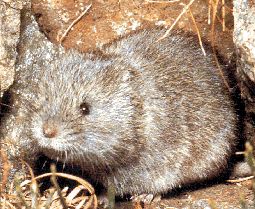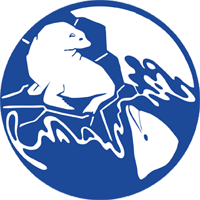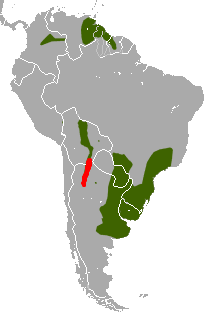
Inia is a genus of river dolphins from South America containing one to four species.

Microtus is a genus of voles found in North America, Europe and northern Asia. The genus name refers to the small ears of these animals. They are stout rodents with short ears, legs and tails. They eat green vegetation such as grasses and sedges in summer, and grains, seeds, root and bark at other times. The genus is also called "meadow voles".

Aonyx is a genus of otters, containing three species, the African clawless otter, the Congo clawless otter, and the Asian small-clawed otter. The word aonyx means "clawless", derived from the prefix a- ("without") and onyx ("claw/hoof").

Diplomesodon is a genus of shrew that contains a single extant species, the piebald shrew (Diplomesodon pulchellus).
Blanfordimys is a subgenus of voles in the family Microtus. It was formerly considered a distinct genus, but taxonomic studies group it within the Microtus radiation.

Chionomys is a genus of rodent in the family Cricetidae.
The juniper vole is a species of rodent in the family Cricetidae. It is found in Afghanistan, China, Pakistan and Tajikistan. It was formerly classified in the genus Neodon, but genetic evidence indicates that it is classified within the subgenus Blanfordimys in Microtus.
The hispid pocket gopher is a species of rodent in the family Geomyidae. It is found in Mexico, Belize, Guatemala, and Honduras. Some authors classify it in the genus Orthogeomys, but recent research has allowed this and its related species to be classified in the genus Heterogeomys.

Richard George Van Gelder was an American mammalogist who served as the Curator of Mammalogy for the American Museum of Natural History in New York for more than twenty-five years.

The Society for Marine Mammalogy was founded in 1981 and is the largest international association of marine mammal scientists in the world.

Oliver Payne Pearson, or "Paynie" to many that knew him, was an American zoologist and ecologist. Over a very active 50-year career, he served as professor of zoology at UC Berkeley and curator of mammals at the Museum of Vertebrate Zoology. Pearson is best known for his work on the role of predation on vole demography and population cycles, and for his piercing contributions to the biology of South American mammals, but his earlier studies on reproductive and physiological ecology are highly regarded as well.

Marcus Ward Lyon Jr. was an American mammalogist, bacteriologist, and pathologist. He was born into a military family, and demonstrated an early interest in zoology by collecting local wildlife around his father's army posts. He graduated from Brown University in 1897, and continued his studies at George Washington University while working part-time at the United States National Museum (USNM). At the same time, he taught at Howard University Medical School and later George Washington University Medical School. He received his Ph.D. from George Washington University in 1913. In 1919, he and his wife, Martha, moved to South Bend, Indiana to join a newly opened clinic. Prior to moving, Lyon had published many papers on mammalogy, both during and after his tenure at the USNM. In these papers, he had formally described six species, three genera, and one family. Once in South Bend, he began to publish medical studies, too, but continued his work in mammalogy, with a particular focus on the local fauna of Indiana. He published more than 160 papers during his career.
Don Ellis Wilson is an American zoologist. His main research field is mammalogy, especially the group of bats which he studied in 65 countries around the world.
Rodrigo A. Medellín is a Mexican ecologist and Senior Professor of Ecology at the Institute of Ecology, University of Mexico (UNAM). Known for his work in bat, jaguar, bighorn sheep and other species conservation, his research has always been designed and conducted to advice conservation policy and conservation decision-making processes in Mexico and 16 other countries for over 40 years.
Jocelyn Mary Taylor was an American mammalogist, who served as president of the American Society of Mammalogists from 1982 to 1984. She was also an honorary trustee of the Cleveland Museum of Natural History. As a pioneer for women in the field of mammalogy, Taylor actively worked to broaden the study, doing so as a member of the American Society of Mammalogists, as a university professor, and through conducting her research, publishing numerous works.
Megalomys georginae is an extinct species of rice rat from Barbados in the genus Megalomys. The species was extant during the Late Pleistocene, and became extinct shortly after European arrival in Barbados.
Eugene Raymond Hall was an American mammalogist.

Neogale is a genus of mustelid native to the Americas, ranging from Alaska south to Bolivia. Members of this genus are known as New World weasels.

Massoia's lutrine opossum is a species of opossum native to South America.
Neotoma insularis, the Angel de la Guarda woodrat, is a species of rodent in the family Cricetidae. It is found in the Mexican state of Baja California on Angel de la Guarda Island.










